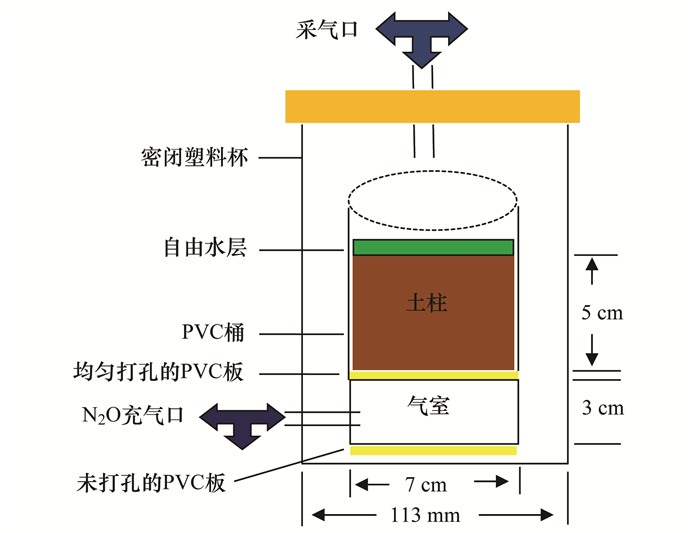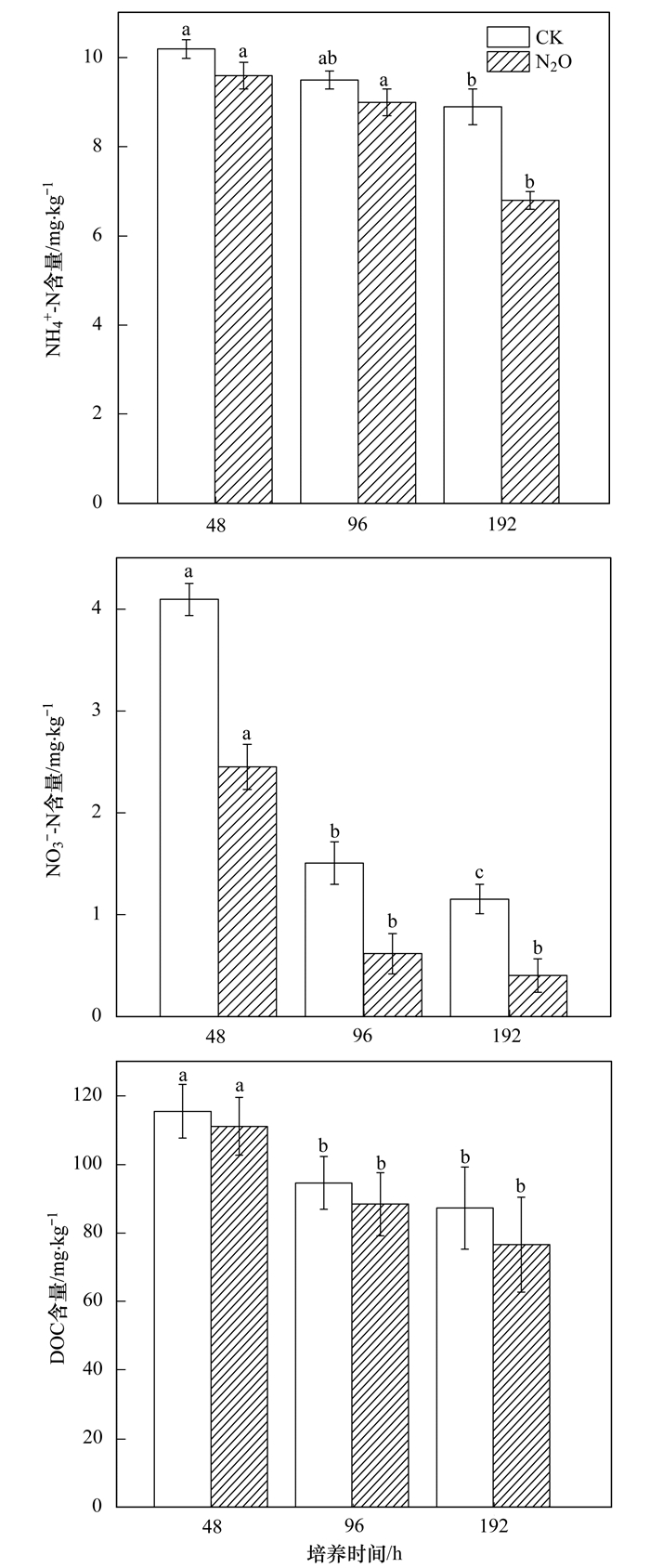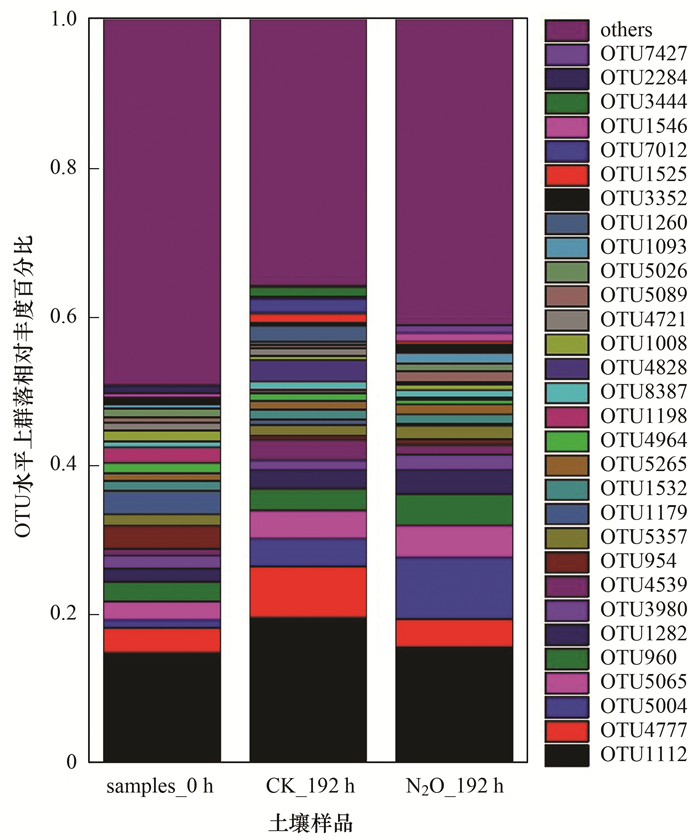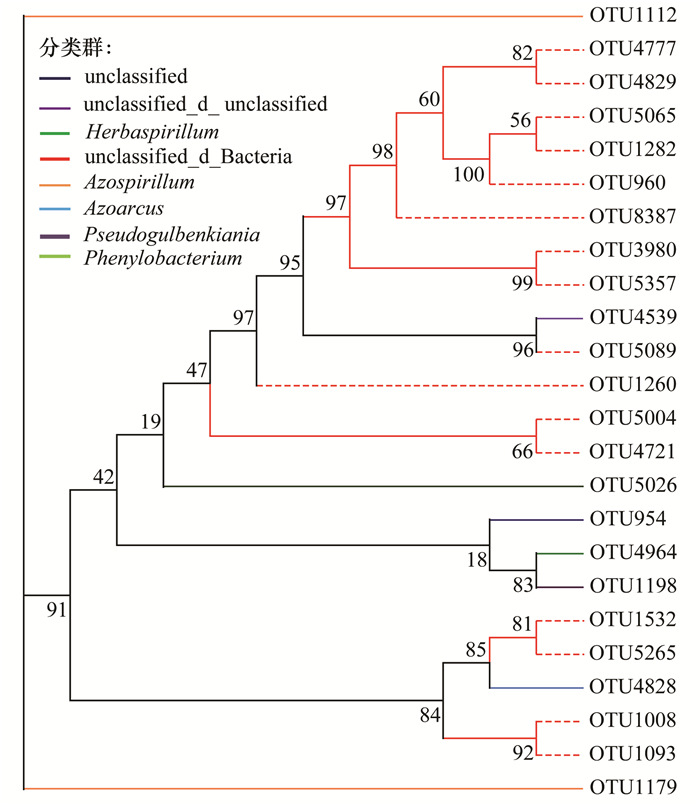2. 中南林业科技大学生命科学与技术学院, 长沙 410004;
3. 湖南农业大学农学院, 长沙 410128;
4. 湖南省宁乡市回龙铺镇农业综合服务中心, 宁乡 410606
2. College of Life Science and Engineering, Central South University of Forestry and Technology, Changsha 410004, China;
3. College of Agronomy, Hunan Agricultural University, Changsha 410128, China;
4. Agricultural Comprehensive Service Center of Hunan Province Ningxiang Huilongpu Town, Ningxiang 410606, China
氧化亚氮(N2O)是一种强效的温室气体[1~3], 对全球气候变暖及大气平流层臭氧耗竭具有重要的影响[4~6].农业土壤是N2O排放的主要源头之一[7, 8], 主要由土壤硝化和反硝化作用来驱动[8, 9].其中, 氮肥的过量施用是农业土壤N2O大量排放的重要原因[4, 10].据报道, 施入农业土壤中的高达70%氮肥通过硝化-反硝化作用转化为氮氧化物气体和N2而损失[4, 11].目前, 关于农业土壤N2O的排放特征已经有了初步认识[2, 12], 然而, 农业土壤N2O的最终排放量由N2O的产生和消纳两个过程共同决定[13, 14].虽然关于农业土壤N2O的产生机制已有少量研究[15], 然而, 关于农业土壤N2O的消纳过程及相关功能微生物的作用机制还缺乏深入了解[14].
土壤N2O消纳的唯一生物途径是由nosZ基因编码的氧化亚氮还原酶(nitrous oxide reductase, N2OR)催化N2O还原成N2的过程[16].在nosZ基因中, nosZ-I是N2O还原剂类群的其中一支, 被称为典型反硝化细菌[16, 17].已有研究表明, 含有nosZ-I基因的微生物属于α-变形菌、β-变形菌以及γ-变形菌, 主要编码Tat信号肽基序[18].nosZ-I分支内不同的反硝化菌还原N2O速率存在差异, 即使同一个种的不同nosZ-I菌株还原N2O的能力差异也很大[19].因此, 明确nosZ-I型功能种群的组成特征及其对N2O浓度变化的应答机制, 对了解土壤N2O的消纳过程具有重要意义[20].
水稻田是一类连续淹水厌氧的人工湿地[15], 不仅是强烈的N2O源, 也是急速的N2O汇[21].其在微生物驱动下极易发生完全反硝化作用[22], 最终将N2O进一步还原为N2[14, 23], 因而对于全球N2O气体减排控制具有重要的意义[11].有研究表明, 无氧条件更有利于氧化亚氮还原酶基因的微生物将N2O转化为N2[6, 14, 24], 且高含水量或淹水条件会导致N2O在土壤溶液中暂时储存, 从而使N2O在排放到土壤表面之前进一步还原为N2的几率增加[14, 25].进一步的研究表明, 外源添加N2O[13, 14]可刺激反硝化过程中的N2O彻底还原为N2[25~29].目前, 关于稻田土壤N2O的消纳过程主要围绕与土壤理化性质之间的关系来开展[4, 26, 27, 30, 31], 而对于稻田土壤N2O的消纳潜力及其微生物驱动机制研究较少.
本研究通过采集南方典型水稻土表层0~5 cm的小型原状土柱, 在严格密闭淹水厌氧条件下, 在土柱底部添加一定浓度的外源N2O气体, 系统监测N2O的消纳过程以及nosZ-I型功能种群组成的演替规律, 探索稻田土壤N2O的消纳潜力以及nosZ-I型功能种群的应答特征, 以期为减少稻田N2O排放提供重要的科学依据.
1 材料与方法 1.1 土样采集与预处理供试土壤于2017年11月采自湖南省常德市桃源县古市镇的水稻田(N28°55′, E111°26′), 为多年连续种植水稻土壤, 此时田间土壤处于休耕渍水状态.该土壤发源于河流冲积物母质, 是典型的中国亚热带地区水稻田土壤.土样采集采用随机多点采样法, 尽量避免残留主根区域, 用自制PVC管(d=7 cm, h=7 cm)采集多个0~7 cm原状水稻土柱, 尽量保证土柱结构完整无破坏.标注方向后用保鲜膜包裹紧实, 带回实验室做后续处理.土壤基本理化性质见表 1.
|
|
表 1 供试土样基础理化性质1) Table 1 Physicochemical properties of paddy soil |
将取回的原状土柱从土表沿PVC管内壁向下移动2 cm, 并距离土表 1 cm处标注记号(用于后续淹水), 用小刀切掉多余的底土, 获得0~5 cm小型土柱(d=7 cm, h=7 cm PVC管包裹).在小型土柱底部覆盖相同尺寸的PVC管(d=7 cm, h=3 cm)自制的通气底座, 并密封边缘.通气底座底部用未打孔的PVC板覆盖并密封边缘, 上部用均匀打孔的PVC板覆盖密封边缘后再覆盖一层透气不透水的硅胶片并密封边缘.确保每个边缘密封完好后将整套装置套于培养用塑料杯(d=113 mm, h=177 mm, 体积=1.3 L)中, 用带有三通阀的F46管连接通气底座与塑料杯外壁, 作为N2O充气口.整套装置如图 1所示.

|
图 1 实验装置示意 Fig. 1 Schematic diagram of the experimental device |
利用图 1所示的实验装置, 将各水稻土柱维持土表1 cm深自由水层不变, 置于25℃±1℃温室均质化预培养10 d.预培养结束后盖上塑料杯盖并完全密封, 浸水测试整体密封效果.随后注射器分别与塑料杯盖采气口和N2O充气口三通阀连接, 对原状土柱塑料杯组合装置重复抽真空-充高纯氦气5次左右, 保证空间内外气压平衡.
1.2 实验设计和样品采集本实验包括2个处理:分别为0 mL(CK, 不充N2O)和10 mL(N2O) 8 000 μmol·mol-1 (以N2O/盆计), 每处理12盆.气体置换完成后, 将整套装置置于厌氧罩(真空压缩袋制, 抽真空后通入高纯He气), 用注射器连接通气底座三通阀, 分别抽出0和10 mL气体后外源输入设定浓度的N2O气体, 开始培养计时, 共密闭培养192 h.
气体样品采集:用注射器分别在密闭培养的24、48、96、144和192 h采集通气底座内气体, 并在6、12、24、36、48、60、72、84、96、120、144、168和192 h采集塑料杯内气体样品1 mL于12 mL真空血清瓶中, 充入29 mL高纯He使气瓶内气体维持高压, 用于N2O含量的测定.每次采集气体样品前用注射器反复(10~15次)抽打装置空间内气体使空间气体混匀, 气体样品采集后立即补入等量高纯He使装置内各空间气压平衡, 采集的气体用气相色谱仪测定其浓度.
土壤样品采集:分4个时间点采集土样, 每个时间点每个处理取3盆土作为重复. 4个时间点包括:0 h(培养前获得的起始土样作为对照)、48 h(N2O浓度上升期)、96 h(N2O浓度稳定期)和192 h(N2O浓度消耗后期).采集方法为:倒掉自由水后充分混匀土样, 取出约20 g土样迅速用锡箔纸包裹, 经由液氮速冻, 放入-80℃保存用于相关分子生物学分析.将剩余土样装入密封袋, 放入4℃保存用于NH4+-N、NO3--N和DOC含量分析, 并在72 h内完成测定.
1.3 氧化亚氮浓度, 无机氮和DOC测定采用气相色谱仪(GC 7890A, Agilent, 美国)测定N2O浓度.检测器为微池电子捕获器63Ni-ECD, 以高纯N2作为色谱柱载气, 载气流压力为28 psi, 检测器温度为300℃, 柱箱温度为50℃.
采集新鲜土壤样品, 采用硫酸钾共提法浸提.用50 mL 0.5 mol·L-1 K2SO4溶液萃取, 并分别用流动注射仪-2018 (AA3, 德国)和岛津-有机碳分析仪(湿法, TOC-vwp, 日本)测定铵态氮(NH4+-N)、硝态氮(NO3--N)含量和DOC含量.
1.4 土壤微生物总DNA抽提和PCR扩增根据E.Z.N.A.® soil试剂盒(Omega Bio-tek, Norcross, GA, U.S.)说明书进行总DNA抽提, DNA浓度和纯度利用NanoDrop2000进行检测, 利用1%琼脂糖凝胶电泳检测DNA提取质量.
测序选用引物nosZ-F[32]和nosZ-1622R[33]扩增nosZ-I基因.PCR扩增体系为5×FastPfu缓冲液4 μL, dNTPs (2.5 mmol)2 μL, 上下游引物(5 μmol)0.8 μL, FastPfu聚合酶0.4 μL, BSA 0.2 μL, DNA模板10 ng, 补ddH2O至20 μL. PCR扩增程序为:95℃ 3 min;95℃ 30 s, 55℃ 30 s, 72℃ 45 s, 35个循环;最后72℃延伸10 min(PCR仪:ABI GeneAmp® 9700型).
1.5 高通量测序及结果处理选取水稻土两个处理中培养了0和192 h的土壤样品, PCR扩增nosZ-I基因, 利用Illumina Miseq PE300测序平台对nosZ-I基因进行双末端(Paired-end)测序(上海美吉生物医药科技有限公司, 中国), 每个样品至少获得3万条有效序列.利用上海美吉生物医药科技有限公司生信云平台进行数据分析和比对, 得到nosZ-I群落α多样性指数, 选择相对丰度大于1%的OTU进行群落组成分析和系统发育树分析.
1.6 数据分析采用Microsoft Excel 2007进行相关数据的计算和预处理.图形制作采用Origin 8.5软件和Word 2007完成, 数据的统计分析均采用IBM SPSS Statistics 21进行.无机氮和DOC含量、氧化亚氮还原酶基因nosZ-I群落α多样性指数差异性分析采用单因素方差分析(One-way ANOVA, Duncan法)进行比较, P<0.05时显著差异.系统发育树构建通过美吉I-Sanger云平台计算(最大似然法, Maximum likelihood ML), 并用MEGA7绘制树.
2 结果与分析 2.1 外源N2O添加处理下表层淹水原状水稻土柱N2O消纳动态在外源N2O添加处理中, 外源实际充入的N2O起始浓度为1 086 mg·L-1, 随着培养时间延长, 土柱底部的N2O气体浓度逐渐降低, 在培养192 h后土柱底部剩余N2O气体浓度为28.38 mg·L-1, 比起始N2O气体浓度减少了97.39%, 表明外源N2O气体大部分扩散、迁移进了原状土柱.而在不充N2O的对照处理中, 在24 h时土柱底部存在少量N2O, 其浓度为71.92 mg·L-1, 这可能是反硝化过程中产生的N2O气体扩散进入土柱底座气室, 随着反硝化过程持续进行被土壤再次吸收消耗, 最终底部N2O气体浓度为15.17 mg·L-1(图 2).逸出土表到土柱顶部空间的N2O浓度, 对照处理与外源N2O处理均呈现先上升后下降的变化趋势, 但N2O气体排放高峰时间出现了差异(图 2), 外源N2O处理在培养第48 h达到排放最高峰值84.12 mg·L-1, 占初始N2O气体浓度的7.75%, 对照处理在第24 h达到最高峰值36.60 mg·L-1, 进一步说明0~5 cm表层原状水稻土柱对土壤释放的N2O吸收率极高.土柱顶部空间, 对照处理和外源N2O处理在厌氧培养至192 h后N2O浓度为7.78 mg·L-1和23.62 mg·L-1, 外源N2O处理比对照多消耗67.10%N2O, N2O浓度消耗速率分别约为0.172 mg·(L·h)-1和0.420 mg·(L·h)-1, 随着时间延长外源N2O有被土壤全部吸收的趋势, 且外源N2O气体极大地提高了土体对N2O气体的吸收速率.

|
CK代表不充N2O气体处理, N2O代表充10 mL N2O气体处理;数值均以平均值表示;误差棒代表标准偏差(n=3), 下同 图 2 0~5 cm深度水稻土柱底部N2O消减动态与土柱顶部空间N2O释放动态 Fig. 2 Dynamics of N2O reduction in the bottom space and N2O emission in the headspace for the paddy soil cores (0-5 cm) |
结果表明, 同一水稻土壤淹水土柱在完全厌氧条件下不添加N2O和外源添加N2O气体处理都能够将土壤产生的N2O消耗完全, 进一步说明淹水厌氧条件下外源N2O气体可以增强原状水稻土对N2O的消耗能力.
2.2 外源N2O添加处理下土壤无机氮和DOC含量动态起始土样NH4+-N含量本底值为10.69 mg·kg-1.在淹水密闭厌氧培养的48~96 h对照和N2O处理的NH4+-N含量分别下降6.86%和6.25%(图 3), 在192 h后NH4+-N含量消耗比例占起始样NH4+-N含量的16.73%和36.38%(P < 0.05).表明淹水密闭厌氧和外源N2O气体添加显著促进了土壤NH4+-N的消耗, 被消耗的NH4+-N可能通过硝化微生物的反硝化作用而转化为N2O.

|
不同小写字母代表同一处理不同时间差异显著 图 3 土壤无机养分动态 Fig. 3 Dynamics of soil inorganic nutrients |
培养前的起始土样NO3--N含量较低, 仅为4.59 mg·kg-1, 淹水密闭培养的48 h和96 h NO3--N含量对照和外源N2O处理消耗比例分别占本底NO3--N含量的10.71%、67.16%和46.53%、86.52%(图 3), 192 h后对照和外源N2O处理分别消耗了3.43 mg·kg-1和4.18 mg·kg-1, 消耗比例分别约占74.83%、91.12%(P < 0.05).这些被消耗的NO3--N极大可能是在厌氧培养前期被水稻土中反硝化微生物作为底物利用而产生N2O.表明外源N2O气体添加显著促进了0~5 cm表层土壤对NO3--N的消耗.
表层水稻土柱本底可利用的有机碳含量较为丰富, DOC含量高达126.69 mg·kg-1(图 3), 随着培养时间的延长两个处理的DOC含量均呈下降趋势.在淹水密闭培养192 h后CK和N2O处理的DOC含量分别消耗了39.50 mg·kg-1和50.15 mg·kg-1, 相对于起始点消耗比例分别占约31.18%和39.59%.DOC是土壤活性有机质, 容易被土壤微生物分解, 在提供水稻土壤养分方面起着重要的作用, 说明淹水厌氧环境下外源N2O气体添加刺激更多的微生物对DOC的摄取.
2.3 氧化亚氮还原酶基因nosZ-I群落α多样性指数选取0和192 h的土壤样品进行Illumina MiSeq测序, 每个样品至少获得3万条有效序列.多重比较结果表明, 0~5 cm原状土柱外源N2O添加前后nosZ-I型反硝化细菌群落α多样性指数均无显著性差异(表 2).此外, 各处理Sobs、Ace和Chao指数较高, 表明0~5 cm水稻土柱nosZ-I型反硝化细菌群落十分丰富.
|
|
表 2 外源N2O添加处理nosZ-I基因群落α多样性指数1) Table 2 The α diversity index of the nosZ-I gene community under the addtion of N2O treatment |
2.4 氧化亚氮还原酶基因nosZ-I群落组成分析和系统发育分析
选择相对丰度大于1%的OTU进行群落组成分析和系统发育树分析(图 4和图 5).结果表明, 初始土样、192 h外源N2O添加和CK这3种处理的土壤中nosZ-I群落组成差异显著.首先, N2O添加后优势菌株OTU5004、OTU5065、OTU960和OTU1282变化较明显, 其相对丰度显著提高.系统发育树结果表明它们亲缘关系密切, 都归为Proteobacteria.其中, N2O添加192 h后, OTU5004菌株相对丰度分别比初始样和CK升高7.30%和4.63%.其次, 外源N2O的添加对一些相对丰度较小的菌株也会产生一定的影响, 甚至同一个属或种的不同菌株在不同处理中相对丰度出现差异.例如, 相比初始样, CK和N2O处理的OTU1532和OTU4828两个菌株丰度分别降低0.09%、0.15%和1.07%、0.15%, OTU5265菌株丰度升高0.18%、0.33%.系统发育树结果表明, OTU1532、OTU5265(unclassified_d_Bacteria)和OTU4828(Azoarcus sp. KH32C)的同源可信度为85%, 显示这3个菌种是Azoarcus sp.的同一个亚种或者变种.另外, 相比初始样, CK、N2O处理的土壤中OTU1008菌株丰度分别降低0.89%、0.68%, OTU1093菌株丰度在CK处理中降低0.25%, 在N2O处理中升高0.78%.系统发育树结果表明, OTU1008和OTU1093(unclassified_d_Bacteria)同源度高达92%, 是同一个菌种, 最终和OTU4828的同源可信度为84%, 显示两枝菌株是Azoarcus sp..

|
Samples-0 h代表培养前获得的0 h起始土样;CK-192 h、N2O-192 h分别代表培养至192 h不充N2O气体和充N2O气体处理采集的土壤样品;数据为平均值(n=3) 图 4 外源N2O添加处理nosZ-I种群在OTU水平上相对丰度 Fig. 4 Abundance of the nosZ-I-containing community on the OTU level under the addtion of N2O treatment |

|
图 5 基于nosZ-I基因序列的系统发育树 Fig. 5 Phylogenetic tree based on the sequences of the nosZ-I gene |
水稻土是典型的农田土壤, 长期淹水厌氧环境导致土壤反硝化能力很强[13, 15, 34].因此, 水稻土普遍存在N2O消纳现象, 可以成为大气N2O的汇库[13, 14].
土壤中的N2O通量主要是由微生物驱动发生, 其扩散也受土壤物理因素影响[14].厌氧培养192 h后, N2O处理土柱底部剩余N2O气体占初始添加量的2.61%, 在持续强烈的反硝化作用下对照处理土柱底部排放的少量N2O气体也几乎全部迁移扩散进入土柱.其可能的原因是绝大部分外源N2O迁移扩散进了水稻土柱, N2O气体向上传输的过程中会被土壤孔隙、结构、水分、微生物截留, 大部分N2O在氧化亚氮还原酶的催化下发生了强烈的完全反硝化作用, 被消耗转化为N2排放, 只有少部分N2O气体逸散到土柱顶部空间[23, 34].进一步说明, 持续淹水厌氧水稻田浅表层土壤N2O排放量很低, 甚至具有很强的N2O吸收能力[14, 35, 36].
有研究认为土壤N2O的排放是N2O产生和还原的净效应[14, 37].本研究结果显示, 厌氧培养开始时NO3--N浓度较低, 外源N2O处理和对照处理土柱顶部空间N2O浓度上升, 其原因可能是反硝化作用强烈, N2O的产生速率高于其还原(消耗)速率, 未被还原成N2的N2O排放进入土柱顶部空间, 表现为N2O在顶部空间的累积[14, 36, 37].Chapuis-Lardy等[14]报道, N2O的消耗和N2的产生受土壤N2O浓度影响.本研究发现随着厌氧培养时间延长, NO3--N浓度逐渐降低, 积累在土柱顶部空间的N2O达到排放高峰后又迅速被土壤吸收(消耗), 外源N2O处理比对照处理土柱顶部空间N2O消耗速率更快, 这与之前的报道一致.例如, Clough等[29]和王玲等[36]的土柱培养研究证实外源添加N2O到土壤中或提高土壤N2O浓度, 可以加快土壤N2O消耗速率.
之前的研究表明, 表层土壤可能是N2O通量的重要贡献者[8], 并且土壤物理生化特性会对氮素循环和N2O排放产生影响[38].厌氧、低NO3-浓度、丰富的有机碳和高水分含量有利于nosZ微生物通过反硝化作用将N2O充分还原为N2, 促进土壤N2O消纳[13].还有研究报道高C含量也可能刺激呼吸, 导致无氧微区发生正常的反硝化作用[24].本研究中土壤本底NH4+-N和NO3--N含量较低, 但有机碳含量较为丰富, 厌氧培养192 h结束后, 对照和N2O添加处理NH4+-N、NO3--N和DOC分别被消耗了16.73%和36.38%、74.83%和91.12%、31.18%和39.59%, 表明淹水厌氧环境和外源N2O添加刺激了更多微生物的呼吸消耗和对碳氮养分的利用, 这可能与N2O还原酶有关[36].
土壤反硝化微生物是土壤生态系统中N2O还原的重要驱动因素[38, 39], 生态系统的差异、尚未探明的环境因素会影响反硝化微生物的群落多样性和组成[40].Rich等[41]在厌氧条件下向泥浆中添加N2O的研究证实了nosZ群落多样性没有差异.本研究结果发现, 不管是添加还是不添加N2O气体, nosZ-I细菌群落多样性没有显著差异.群落组成分析结果显示初始土样、192 h外源N2O添加和CK处理这3种土壤中nosZ-I优势菌株OTU5004、OTU5065、OTU960和OTU1282的相对丰度差异显著, 外源N2O显著提高OTU5004菌株的相对丰度, 且外源N2O添加比CK的N2O消耗速率提高了约1.45倍.其可能原因是当土壤硝酸盐浓度较低时N2O成为反硝化过程的唯一电子受体[13, 26], 提高土壤N2O浓度或外源添加N2O会刺激反硝化过程中更多氧化亚氮还原酶微生物的响应, 将N2O彻底还原为N2[13, 14, 28, 36, 42].已有研究报道微生物群落组成的差异可能会影响N2O的消耗速率, 从而影响土壤中的N2O通量[14].此外, 本研究发现淹水厌氧环境下外源N2O气体添加后, nosZ-I同一个属内的菌株或者同一个种的不同菌株(如Azoarcus sp.)相对丰度差异显著.Sameshima-Saito等[19]证实了nosZ-I分支内不同的反硝化菌或同一个种的不同nosZ-I菌株N2O还原速率存在差异.
4 结论(1) 外源N2O添加显著促进土壤N2O消耗速率, 激发土壤N2O的消纳能力, 从而降低水稻土N2O的排放量.
(2) 外源N2O的添加显著促进稻田土壤对NH4+-N、NO3--N和DOC的消耗, 显著改变nosZ-I型功能微生物的群落组成.
(3) 总之, 外源N2O添加促进0~5 cm深度稻田土壤中N2O还原成N2的过程, 这为降低稻田N2O排放提供新的理论依据.
| [1] | Crutzen P J. The influence of nitrogen oxides on atmospheric ozone content[A]. Paul J. Crutzen: A Pioneer on Atmospheric Chemistry and Climate Change in the Anthropocene[M]. Cham: Springer, 2016. 108-116. |
| [2] | Loick N, Dixon E, Abalos D, et al. "Hot spots" of N and C impact nitric oxide, nitrous oxide and nitrogen gas emissions from a UK grassland soil[J]. Geoderma, 2017, 305: 336-345. DOI:10.1016/j.geoderma.2017.06.007 |
| [3] |
邹娟, 胡学玉, 张阳阳, 等. 生物炭介导的不同地表条件下土壤N2O的排放特征[J]. 环境科学, 2017, 38(5): 2093-2101. Zou J, Hu X Y, Zhang Y Y, et al. Characteristics of biochar-mediated N2O emissions from soils of different surface conditions[J]. Environmental Science, 2017, 38(5): 2093-2101. |
| [4] | Braker G, Conrad R. Diversity, structure, and size of N2O-producing microbial communities in soils-what matters for their functioning?[J]. Advances in Applied Microbiology, 2011, 75: 33-70. DOI:10.1016/B978-0-12-387046-9.00002-5 |
| [5] | Pomowski A, Zumft W G, Kroneck P M, et al. N2O binding at a[4Cu: 2S] copper-sulphur cluster in nitrous oxide reductase.[J]. Nature, 2011, 477(7363): 234-237. |
| [6] | Chen Z, Liu J B, Wu M N, et al. Differentiated response of denitrifying communities to fertilization regime in paddy soil[J]. Microbial Ecology, 2012, 63(2): 446-459. DOI:10.1007/s00248-011-9909-5 |
| [7] | Mosier A R, Duxbury J M, Freney J R, et al. Assessing and mitigating N2O emissions from agricultural soils[J]. Climatic Change, 1998, 40(1): 7-38. |
| [8] | Yano M, Toyoda S, Tokida T, et al. Isotopomer analysis of production, consumption and soil-to-atmosphere emission processes of N2O at the beginning of paddy field irrigation[J]. Soil Biology and Biochemistry, 2014, 70: 66-78. DOI:10.1016/j.soilbio.2013.11.026 |
| [9] |
刘杏认, 赵光昕, 张晴雯, 等. 生物炭对华北农田土壤N2O通量及相关功能基因丰度的影响[J]. 环境科学, 2018, 39(8): 3816-3825. Liu X R, Zhao G X, Zhang Q W, et al. Effects of biochar on nitrous oxide fluxes and the abundance of related functional genes from agriculture soil in the north China plain[J]. Environmental Science, 2018, 39(8): 3816-3825. |
| [10] |
朱永官, 王晓辉, 杨小茹, 等. 农田土壤N2O产生的关键微生物过程及减排措施[J]. 环境科学, 2014, 35(2): 792-800. Zhu Y G, Wang X H, Yang X R, et al. Key microbial processes in nitrous oxide emissions of agricultural soil and mitigation strategies[J]. Environmental Science, 2014, 35(2): 792-800. |
| [11] | Cucu M A, Marhan S, Said-Pullicino D, et al. Resource driven community dynamics of NH4+ assimilating and N2O reducing archaea in a temperate paddy soil[J]. Pedobiologia, 2017, 62: 16-27. DOI:10.1016/j.pedobi.2017.02.001 |
| [12] | Wu D, Wei Z J, Well R, et al. Straw amendment with nitrate-N decreased N2O/(N2O+N2) ratio but increased soil N2O emission:A case study of direct soil-born N2 measurements[J]. Soil Biology and Biochemistry, 2018, 127: 301-304. DOI:10.1016/j.soilbio.2018.10.002 |
| [13] | Majumdar D. Biogeochemistry of N2O uptake and consumption in submerged soils and rice fields and implications in climate change[J]. Critical Reviews in Environmental Science and Technology, 2013, 43(24): 2653-2684. DOI:10.1080/10643389.2012.694332 |
| [14] | Chapuis-Lardy L, Wrage N, Metay A, et al. Soils, a sink for N2O? A review[J]. Global Change Biology, 2007, 13(1): 1-17. |
| [15] | Wang L, Sheng R, Yang H C, et al. Stimulatory effect of exogenous nitrate on soil denitrifiers and denitrifying activities in submerged paddy soil[J]. Geoderma, 2017, 286: 64-72. DOI:10.1016/j.geoderma.2016.10.023 |
| [16] | Juhanson J, Hallin S, Söderström M, et al. Spatial and phyloecological analyses of nosZ genes underscore niche differentiation amongst terrestrial N2O reducing communities[J]. Soil Biology and Biochemistry, 2017, 115: 82-91. DOI:10.1016/j.soilbio.2017.08.013 |
| [17] | Hallin S, Philippot L, Löffler F E, et al. Genomics and ecology of novel N2O-reducing microorganisms[J]. Trends in Microbiology, 2018, 26(1): 43-55. DOI:10.1016/j.tim.2017.07.003 |
| [18] | Jones C M, Graf D R H, Bru D, et al. The unaccounted yet abundant nitrous oxide-reducing microbial community:a potential nitrous oxide sink[J]. The ISME Journal, 2013, 7(2): 417-26. DOI:10.1038/ismej.2012.125 |
| [19] | Sameshima-Saito R, Chiba K, Hirayama J, et al. Symbiotic Bradyrhizobium japonicum reduces N2O surrounding the soybean root system via nitrous oxide reductase[J]. Applied and Environmental Microbiology, 2006, 72(4): 2526-2532. DOI:10.1128/AEM.72.4.2526-2532.2006 |
| [20] | Conthe M, Parchen C, Stouten G, et al. O2 versus N2O respiration in a continuous microbial enrichment[J]. Applied Microbiology and Biotechnology, 2018, 102(20): 8943-8950. DOI:10.1007/s00253-018-9247-3 |
| [21] | Schlesinger W H. An estimate of the global sink for nitrous oxide in soils[J]. Global Change Biology, 2013, 19(10): 2929-2931. DOI:10.1111/gcb.12239 |
| [22] |
刘若萱, 贺纪正, 张丽梅. 稻田土壤不同水分条件下硝化/反硝化作用及其功能微生物的变化特征[J]. 环境科学, 2014, 35(11): 4275-4283. Liu R X, He J Z, Zhang L M. Response of nitrification/denitrification and their associated microbes to soil moisture change in paddy soil[J]. Environmental Science, 2014, 35(11): 4275-4283. |
| [23] | Liu L J, Kong J B, Chen W W, Cui H. Effect of land use on the denitrification, abundance of denitrifiers, and total nitrogen gas production in the subtropical region of China[J]. Biology and Fertility of Soils, 2014, 50(1): 105-113. DOI:10.1007/s00374-013-0839-x |
| [24] | Mathieu O, Lévêque J, Hénault C, et al. Emissions and spatial variability of N2O, N2 and nitrous oxide mole fraction at the field scale, revealed with15N isotopic techniques[J]. Soil Biology and Biochemistry, 2006, 38(5): 941-951. DOI:10.1016/j.soilbio.2005.08.010 |
| [25] | Clough T J, Sherlock R R, Rolston D E. A review of the movement and fate of N2O in the subsoil[J]. Nutrient Cycling in Agroecosystems, 2005, 72(1): 3-11. DOI:10.1007/s10705-004-7349-z |
| [26] | Jones C M, Spor A, Brennan F P, et al. Recently identified microbial guild mediates soil N2O sink capacity[J]. Nature Climate Change, 2014, 4(9): 801-805. DOI:10.1038/nclimate2301 |
| [27] | Buchen C, Lewicka-Szczebak D, Flessa H, et al. Estimating N2O processes during grassland renewal and grassland conversion to maize cropping using N2O isotopocules[J]. Rapid Communications in Mass Spectrometry, 2018, 32(13): 1053-1067. DOI:10.1002/rcm.8132 |
| [28] | Rosenkranz P, Brüggemann N, Papen H, et al. N2O, NO and CH4 exchange, and microbial N turnover over a mediterranean pine forest soil[J]. Biogeosciences, 2005, 3(2): 673-702. |
| [29] | Clough T J, Kelliher F M, Wang Y P, et al. Diffusion of 15N-labelled N2O into soil columns:a promising method to examine the fate of N2O in subsoils[J]. Soil Biology and Biochemistry, 2006, 38(6): 1462-1468. DOI:10.1016/j.soilbio.2005.11.002 |
| [30] | Domeignoz-Horta L A, Putz M, Spor A, et al. Non-denitrifying nitrous oxide-reducing bacteria-an effective N2O sink in soil[J]. Soil Biology and Biochemistry, 2016, 103: 376-379. DOI:10.1016/j.soilbio.2016.09.010 |
| [31] | Assémien F L, Cantarel A A M, Florio A, et al. Different groups of nitrite-reducers and N2O-reducers have distinct ecological niches and functional roles in West African cultivated soils[J]. Soil Biology and Biochemistry, 2019, 129: 39-47. DOI:10.1016/j.soilbio.2018.11.003 |
| [32] | Kloos K, Mergel A, Rösch C, et al. Denitrification within the genus azospirillum and other associative bacteria[J]. Functional Plant Biology, 2001, 28(9): 991-998. DOI:10.1071/PP01071 |
| [33] | Throbäck I N, Enwall K, Jarvis Å, et al. Reassessing PCR primers targeting nirS, nirK and nosZ genes for community surveys of denitrifying bacteria with DGGE[J]. FEMS Microbiology Ecology, 2004, 49(3): 401-417. DOI:10.1016/j.femsec.2004.04.011 |
| [34] | Goldberg S D, Gebauer G. N2O and NO fluxes between a norway spruce forest soil and atmosphere as affected by prolonged summer drought[J]. Soil Biology and Biochemistry, 2009, 41(9): 1986-1995. DOI:10.1016/j.soilbio.2009.07.001 |
| [35] | Hansen M, Clough T J, Elberling B. Flooding-induced N2O emission bursts controlled by pH and nitrate in agricultural soils[J]. Soil Biology and Biochemistry, 2014, 69: 17-24. DOI:10.1016/j.soilbio.2013.10.031 |
| [36] |
王玲, 邢肖毅, 秦红灵, 等. 淹水水稻土消耗N2O能力及机制[J]. 环境科学, 2017, 38(4): 1633-1639. Wang L, Xing X Y, Qin H L, et al. N2O consumption ability of submerged paddy soil and the regulatory mechanism[J]. Environmental Science, 2017, 38(4): 1633-1639. |
| [37] |
续勇波, 蔡祖聪. 亚热带土壤氮素反硝化过程中N2O的排放和还原[J]. 环境科学学报, 2008, 28(4): 731-737. Xu Y B, Cai Z C. Nitrous oxide emission and reduction during denitrification in subtropical soils[J]. Acta Scientiae Circumstantiae, 2008, 28(4): 731-737. DOI:10.3321/j.issn:0253-2468.2008.04.019 |
| [38] | Yang H C, Sheng R, Zhang Z X, et al. Responses of nitrifying and denitrifying bacteria to flooding-drying cycles in flooded rice soil[J]. Applied Soil Ecology, 2016, 103: 101-109. DOI:10.1016/j.apsoil.2016.03.008 |
| [39] |
冯洁, 张克强, 陈思, 等. 土壤N2O吸收和消耗机制及研究进展[J]. 农业环境科学学报, 2014, 33(11): 2084-2089. Feng J, Zhang K Q, Chen S, et al. Mechanism of N2O uptake and consumption by soil. A review[J]. Journal of Agro-Environment Science, 2014, 33(11): 2084-2089. DOI:10.11654/jaes.2014.11.002 |
| [40] | Wallenstein M D, Myrold D D, Firestone M, et al. Environmental controls on denitrifying communities and denitrification rates:insights from molecular methods[J]. Ecological Applications, 2006, 16(6): 2143-2152. DOI:10.1890/1051-0761(2006)016[2143:ECODCA]2.0.CO;2 |
| [41] | Rich J J, Myrold D D. Community composition and activities of denitrifying bacteria from adjacent agricultural soil, riparian soil, and creek sediment in Oregon, USA[J]. Soil Biology and Biochemistry, 2004, 36(9): 1431-1441. DOI:10.1016/j.soilbio.2004.03.008 |
| [42] |
朱思佳, 马莹玲, 高人, 等. 中亚热带森林土壤N2O消耗潜势及其控制因素研究[J]. 环境科学学报, 2019, 39(5): 1673-1681. Zhu S J, Ma Y L, Gao R, et al. N2O consumption potentials and controlling factors in forest soils of mid-subtropical China[J]. Acta Scientiae Circumstantiae, 2019, 39(5): 1673-1681. |
 2020, Vol. 41
2020, Vol. 41


